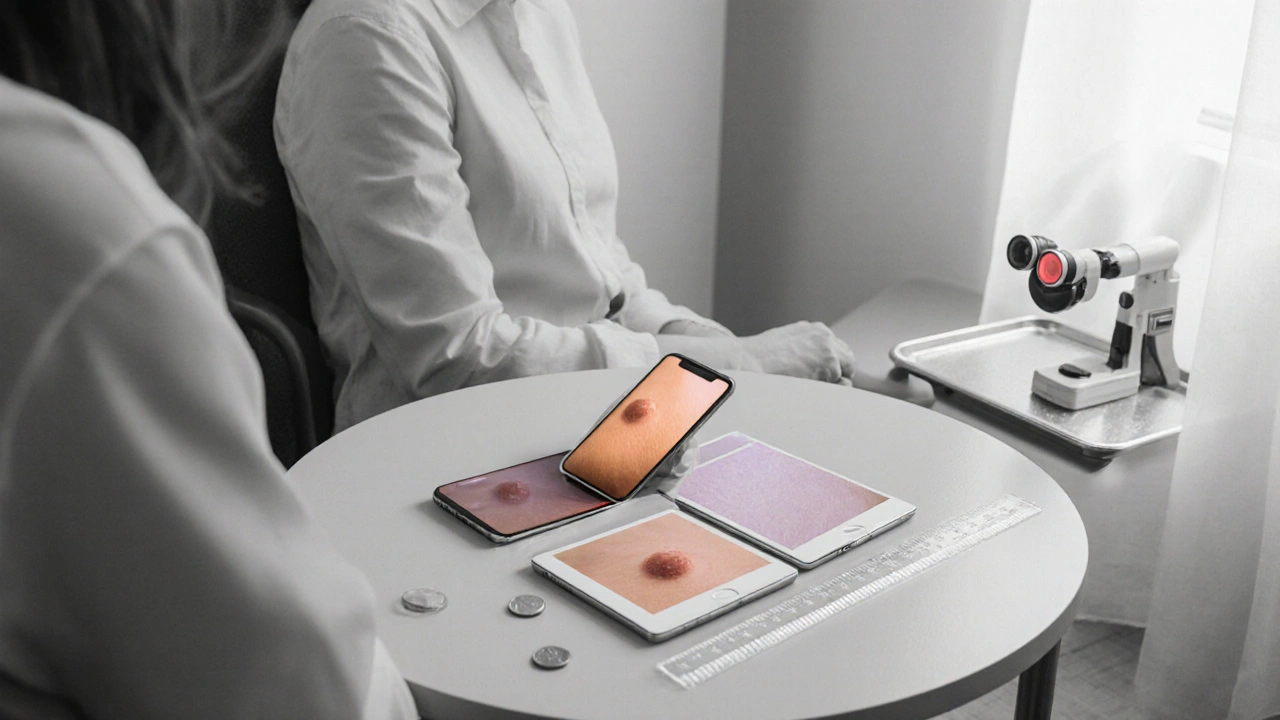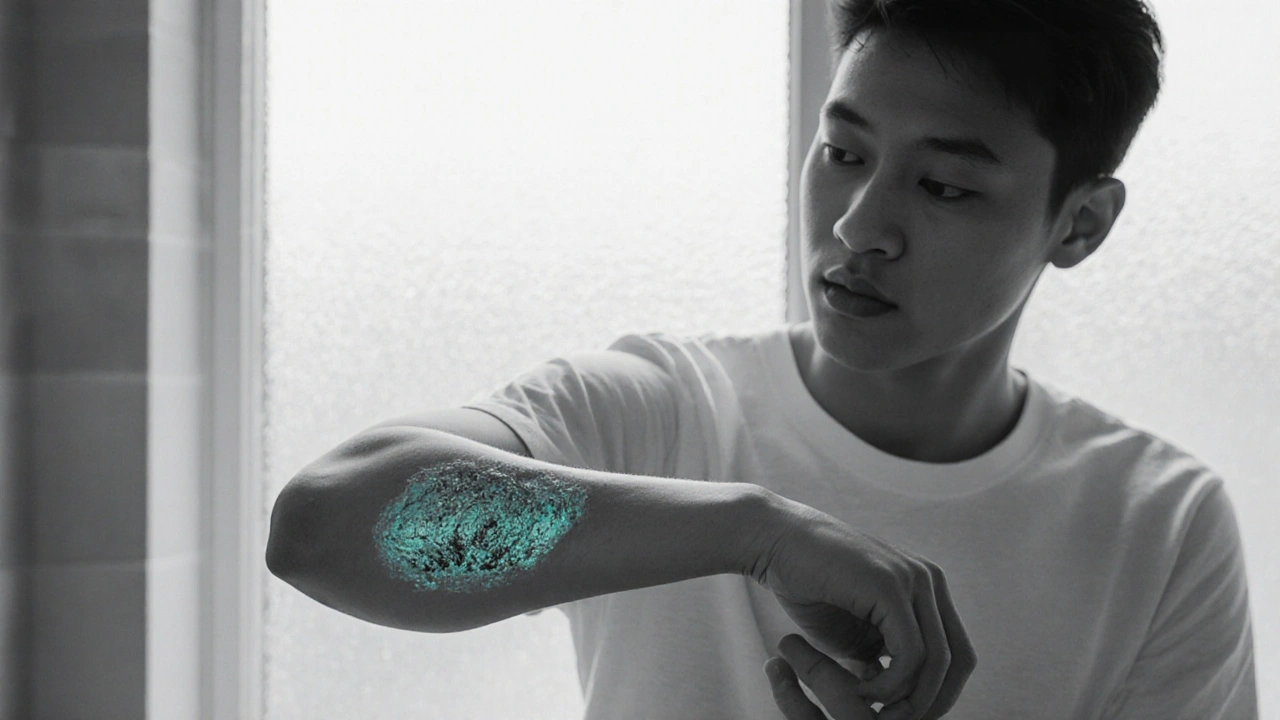When you notice Scaly Overgrowths of Skin a type of skin lesion that appears as thick, flaky patches, it can feel unsettling. You might wonder whether it’s something harmless or a sign of a deeper issue, and the biggest question is often, “How do I get the most out of my upcoming doctor’s appointment?” This guide walks you through every step - from spotting red flags to gathering the right photos - so you walk into the clinic feeling confident and prepared.
Understand What You’re Looking At
Scaly skin growths come in many shapes and sizes. While they’re usually benign, certain patterns hint at conditions that need medical attention. Here’s a quick snapshot of the most common culprits:
- Psoriasis - well‑defined, silvery plaques that often appear on elbows, knees, and scalp.
- Eczema (atopic dermatitis) - itchy, red patches that can become thick and scaly after repeated scratching.
- Seborrheic keratosis - waxy, raised bumps that look like they’re stuck on the skin; they’re harmless but can be mistaken for melanoma.
- Fungal infections (tinea) - ring‑shaped lesions with a scaly border and clear centre.
- Actinic keratosis - rough, sand‑paper‑like spots caused by sun damage; they have a small risk of turning cancerous.
Knowing which category your growth falls into helps you ask the right questions and speeds up the diagnostic process.
When to Book the Appointment
Not every scaly patch needs a specialist, but these signs suggest you should see a Dermatologist sooner rather than later:
- Rapid growth or change in color.
- Bleeding, crusting, or ulceration.
- Persistent itch that disrupts sleep.
- Presence of multiple new lesions over a short period.
- History of skin cancer or a strong family history.
If any of these apply, aim to schedule an appointment within two weeks. For non‑urgent cases, a three‑to‑four‑week window is usually fine.
Gather Your Personal Health Data
Dermatology appointments run smoother when you come prepared with a clear picture of your medical background. Here’s what to collect:
- Medication list - include prescription, over‑the‑counter, and any topical creams you’ve tried.
- Allergy information - especially to latex, adhesives, or common skin‑care ingredients.
- Family skin‑health history - note any relatives with psoriasis, eczema, or skin cancer.
- Previous diagnoses - jot down past skin conditions, biopsy results, or laser treatments.
- Lifestyle factors - sun exposure habit, recent travel to humid climates, or new personal‑care products.
Having this data on hand lets the dermatologist focus on the lesion itself rather than hunting for background information.
Document the Lesion Properly
Photos are the single most valuable tool you can bring. Follow these tips for clear, useful images:
- Use a smartphone with a decent camera (8MP or higher).
- Clean the area gently with water - no harsh soaps - to avoid glare.
- Take three shots: a close‑up (2‑3cm away), a medium view (showing surrounding skin), and a wide shot (for body‑location context).
- Include a ruler or a common object (like a coin) for scale.
- Capture the lesion under natural lighting; avoid flash if it washes out color.
Label each photo with the date and body part (e.g., “2025‑10‑14-left forearm”). If you’re comfortable, upload the set to a secure folder and bring a printed copy.

Prepare a List of Questions
Feeling nervous is normal, so having a script helps you remember the key points. Consider asking:
- What is the most likely diagnosis based on the appearance?
- Do I need a skin biopsy, and what does that involve?
- What treatment options are available - topical, oral, or procedural?
- How long will it take to see improvement?
- Are there lifestyle changes that can prevent recurrence?
Write these down on a small notebook or your phone so you can reference them during the visit.
What to Expect During the Visit
The dermatologist will usually follow this flow:
- History check - they’ll confirm your medical data and ask about symptom onset.
- Visual exam - a thorough inspection of the lesion and surrounding skin.
- Dermatoscopy - a handheld magnifier that reveals patterns invisible to the naked eye.
- Biopsy (if needed) - a small sample taken with a punch tool, then sent to pathology.
- Treatment plan discussion - prescription creams, oral meds, or procedural options like cryotherapy.
Most appointments last between 15 and 30minutes, but the exact time depends on complexity.
After‑Visit Follow‑Up
Once you leave the clinic, keep a simple log of any new symptoms or side effects from prescribed treatments. Typical follow‑up actions include:
- Applying topical creams exactly as directed (usually once or twice daily).
- Scheduling a return visit in 4‑6weeks to assess response.
- Monitoring for signs of infection - increased redness, pus, or fever.
- Maintaining a sun‑protection routine: SPF30+ sunscreen, hats, and UV‑protective clothing.
If you notice any worsening, call the clinic promptly; many dermatology offices have nurse lines for urgent concerns.

Comparison of Common Scaly Conditions
| Condition | Typical Location | Appearance | Trigger | Treatment |
|---|---|---|---|---|
| Psoriasis | Elbows, knees, scalp | Well‑defined, silvery plaques | Genetic, immune‑mediated | Topical steroids, biologics |
| Eczema | Hands, behind knees, face | Red, itchy, thickened | Allergens, irritants | Moisturizers, calcineurin inhibitors |
| Seborrheic keratosis | Trunk, face, arms | Waxy, stuck‑on bumps | Age‑related | Cryotherapy, curettage |
| Tinea (fungal) | Feet, groin, scalp | Ring‑shaped, scaly border | Fungal exposure | Antifungal creams/oral meds |
| Actinic keratosis | Sun‑exposed areas | Rough, sand‑paper texture | Chronic UV exposure | Topical 5‑fluorouracil, cryotherapy |
Use this table as a quick reference when you discuss symptoms with your dermatologist. It also helps you remember which treatment pathways might be suggested.
Pro Tips to Make the Most of Your Visit
- Arrive early - fill out any paperwork in the waiting room; it gives you extra minutes for questions.
- Bring a support person - they can help note down instructions you might forget.
- Wear simple clothing - a short‑sleeve shirt or loose top makes it easy for the doctor to see the lesion.
- Ask for written instructions - especially dosage schedules for creams or oral meds.
- Confirm follow‑up logistics - know whether you need a separate appointment for biopsy results.
Following these small steps can cut down on stress and ensure you leave with a clear action plan.
Bottom Line
Preparing for a dermatologist visit isn’t rocket science. A bit of homework - noting your medical history, snapping clear photos, and drafting questions - goes a long way toward a precise diagnosis and an effective treatment plan. Keep the checklist handy, and you’ll turn that uneasy waiting room moment into a confident step toward healthier skin.
Frequently Asked Questions
How long does a skin biopsy take?
A punch biopsy usually lasts under five minutes. After a small numbing injection, the doctor removes a tiny core of tissue, closes the site with a stitch or steri‑strip, and sends it to a lab. You’ll typically get results within 3‑7days.
Can I treat scaly patches at home before seeing a doctor?
Mild irritation can be soothed with fragrance‑free moisturizers and over‑the‑counter hydrocortisone (1%). However, if the lesion is new, changing, or painful, you should book an appointment instead of relying on home care.
Is sunscreen necessary if my lesion is on a covered area?
Yes. UV rays can penetrate clothing, especially thin fabrics, and contribute to conditions like actinic keratosis. Applying SPF30+ daily is a safe habit for all skin, regardless of lesion location.
Will my insurance cover a dermatologist visit?
Most UK NHS plans refer you to a dermatologist through your GP. Private insurance usually covers specialist visits if you have a referral. Check your policy’s specialist‑consultation clause for exact details.
How often should I schedule skin checks after treatment?
For chronic conditions like psoriasis, a follow‑up every 3‑6months is typical. If you’ve had a biopsy for a suspicious lesion, a 6‑month check is common until the area stabilises.


